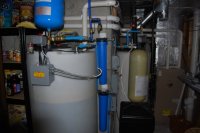Bill Braun
New Member
Had the plumber out because I had no water pressure. Turned out to be a blown fuse (frn-r-8). He replaced the fuse with a frn-r-10. The pressure tank I have is very small (4.6 gallon). He said the fuse may have blown because the system recycles quite often. He suggested adding an additional 33 gallon pressure tank. As I understood him I would just tap into to 3/4" supply line. What fittings will I need to do this. My system is mostly pex. Will I need all this?http://www.amazon.com/Installation-Pressure-SQUARE-pressure-switch/dp/B00SW0E26I/ref=sr_1_16?ie=UTF8&qid=1448058262&sr=8-16&keywords=well pressure tank?
or just a tank T that I will tie into the supply line?
Thanks for the help.
Bill
or just a tank T that I will tie into the supply line?
Thanks for the help.
Bill

